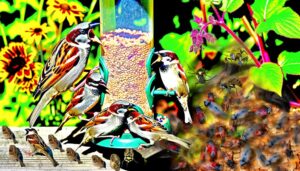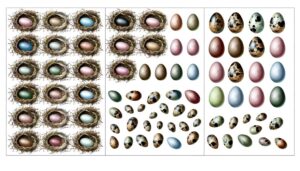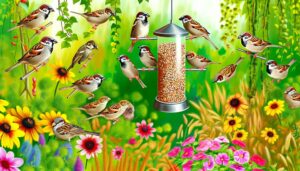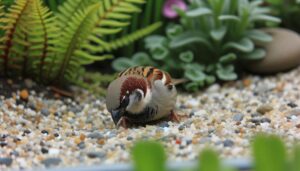5 Steps to Save House Sparrow Eggs if Mother Abandons Nest
To save house sparrow eggs if the mother abandons the nest, first observe the nest for at least two hours to confirm abandonment. Use a thermometer to check egg warmth and document the environment.
Next, gather supplies including a thermometer, hygrometer, heat lamp, and soft materials. Create a makeshift incubator with an insulated container, lining it with clean materials and ensuring appropriate heat, humidity (50-55%), and ventilation.
Maintain optimum temperature around 37.5°C. Regularly monitor egg development using candling and adjust conditions as needed.
Precise methodology is essential for increasing the chances of successful hatching and further insights can optimize care.
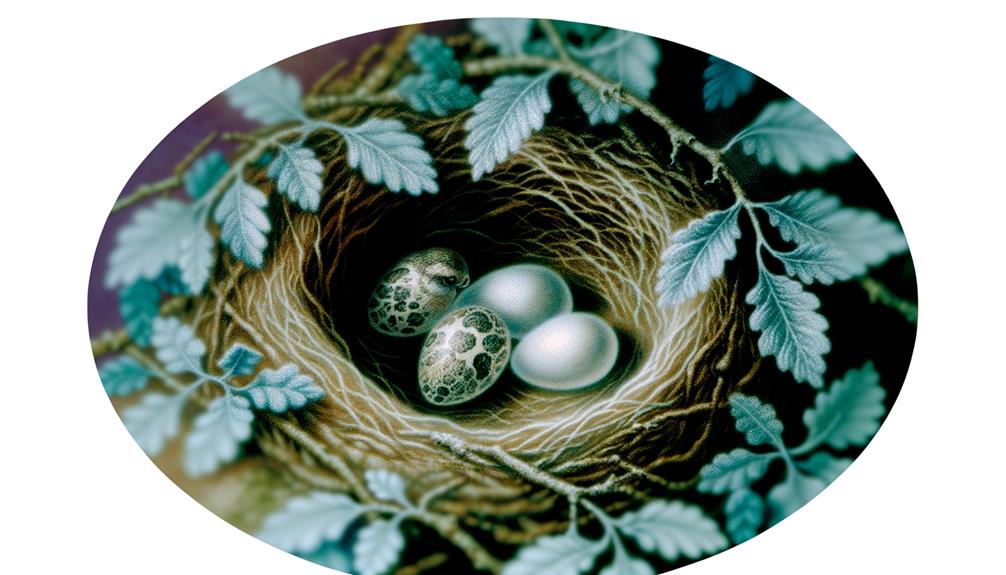
Key Takeaways
- Monitor the Nest: Observe the nest for at least two hours to confirm abandonment by the mother.
- Check Egg Warmth: Use a thermometer to check if the eggs are warm, indicating recent parental presence.
- Create an Incubator: Set up a makeshift incubator with a reliable heat source, maintaining 37.5°C and 50-55% humidity.
- Use Clean Materials: Line the incubator with soft, clean materials like cotton for cushioning the eggs.
- Maintain Optimal Conditions: Continuously monitor and adjust temperature and humidity levels, ensuring proper ventilation and consistent conditions.
Assess the Situation
Before intervening, it is critical to precisely determine whether the house sparrow eggs have indeed been abandoned by the mother.
To begin with, observe the nest from a safe distance for at least two hours; house sparrows frequently leave the nest temporarily for food. Note any signs of parental activity, such as feeding and incubation behaviors.
Additionally, examine the eggs for warmth, as cold eggs may indicate neglect. Utilize a thermometer for accurate temperature assessment, fostering minimal disruption.
Document the nest's environment, considering potential threats or disturbances that might cause temporary abandonment.
Gather Necessary Supplies
Acquiring the appropriate supplies is essential to guarantee the successful incubation and care of abandoned house sparrow eggs.
First, obtain a reliable thermometer to monitor temperature accurately, critical for maintaining the eggs at an ideal 37.5°C (99.5°F).
Next, secure a hygrometer to measure humidity levels, aiming for 50-65% relative humidity.
Additionally, source a heat lamp or heating pad to provide consistent warmth.
Soft, clean materials like cotton or tissue paper are needed to cushion the eggs, preventing jostling and damage.
Finally, prepare a shallow dish of water to maintain humidity and a small, sterile syringe for occasional egg-turning to mimic natural conditions.
These supplies form the foundation for the eggs' care until they hatch.
Create a Makeshift Incubator
To guarantee the proper incubation of abandoned house sparrow eggs, constructing a makeshift incubator with controlled temperature and humidity is essential. Begin by selecting a small, insulated container that minimizes heat loss. Line the bottom with soft, clean materials to cushion the eggs.
Next, install a reliable heat source, such as a low-wattage heat lamp or a heating pad, ensuring it maintains a steady temperature.
Thermometer and Hygrometer: Use these instruments to monitor and adjust temperature and humidity levels.
Ventilation Holes: Create small holes to allow for necessary air exchange without significant heat loss.
Water Source: Place a small dish of water inside to maintain adequate humidity.
These components are critical for replicating the natural incubation environment.
Maintain Optimal Conditions
Maintaining ideal conditions within the makeshift incubator requires continuous monitoring and precise adjustments to both temperature and humidity levels. The best temperature for house sparrow eggs is approximately 37.5°C (99.5°F). Deviations can hinder embryonic development, leading to malformed chicks or mortality. Utilize a dependable digital thermometer and adjust the heat source as needed.
Humidity should be maintained at around 50-55% to prevent desiccation of the egg's contents or excessive moisture, which can also be harmful. Hygrometers are vital for accurate readings. Guarantee adequate air circulation within the incubator to facilitate gas exchange.
Periodic checks are essential to maintaining stable conditions, as fluctuations can have irreversible impacts on the viability of the developing embryos.
Monitor Egg Development
Regularly evaluating the progress of embryonic development in house sparrow eggs is essential to guarantee successful hatching. To achieve this, it is vital to utilize a systematic approach that incorporates various observational and diagnostic techniques.
- Candling: Shine a bright light through the egg to observe the embryo's growth and detect any abnormalities.
- Temperature Monitoring: Maintain a consistent temperature around 37.5°C (99.5°F) to support optimal development.
- Humidity Control: Maintain a humidity level of 50-65% to prevent dehydration or excess moisture in the egg.
These methods provide valuable insights into the eggs' viability and development stages. By employing these techniques, one can identify potential issues early and take corrective measures, thereby enhancing the likelihood of successful hatching.
Prepare for Hatching
As the eggs approach the final stages of development, it becomes essential to create an environment that supports the hatching process. Maintaining a consistent temperature of approximately 99-100°F (37.2-37.8°C) is vital, achieved through a calibrated incubator. Humidity levels should be kept at 50-55% to prevent desiccation, increasing to 65-70% during the final three days to facilitate shell softening.
Guarantee the incubator is free from contaminants, as sterility mitigates bacterial risks. Ventilation is also crucial, providing a steady supply of fresh air without causing temperature fluctuations. Regularly observe the eggs for pipping, the initial break in the shell, and be prepared to assist if chicks struggle to emerge, ensuring minimal intervention to avoid injury.
Conclusion
To successfully save house sparrow eggs if the mother abandons the nest, it is essential to assess the situation, gather necessary supplies, create a makeshift incubator, maintain ideal conditions, monitor egg development, and prepare for hatching.
Each step, from initial evaluation to final preparation, involves critical attention to detail and adherence to specific protocols.
By following these systematic procedures, one can notably increase the likelihood of successfully hatching and raising healthy house sparrows.


